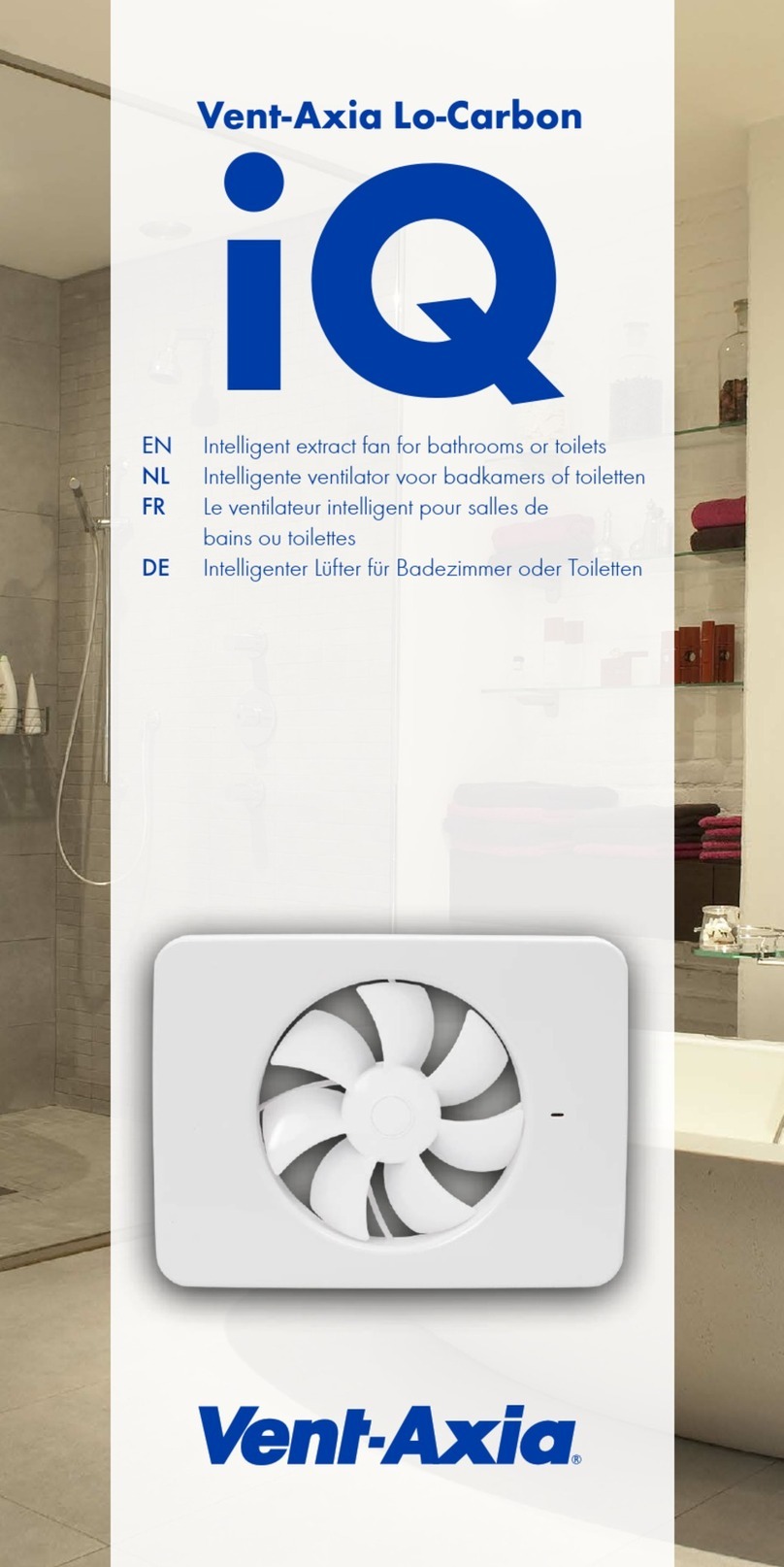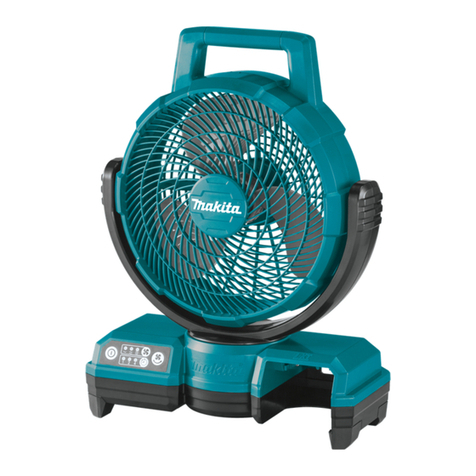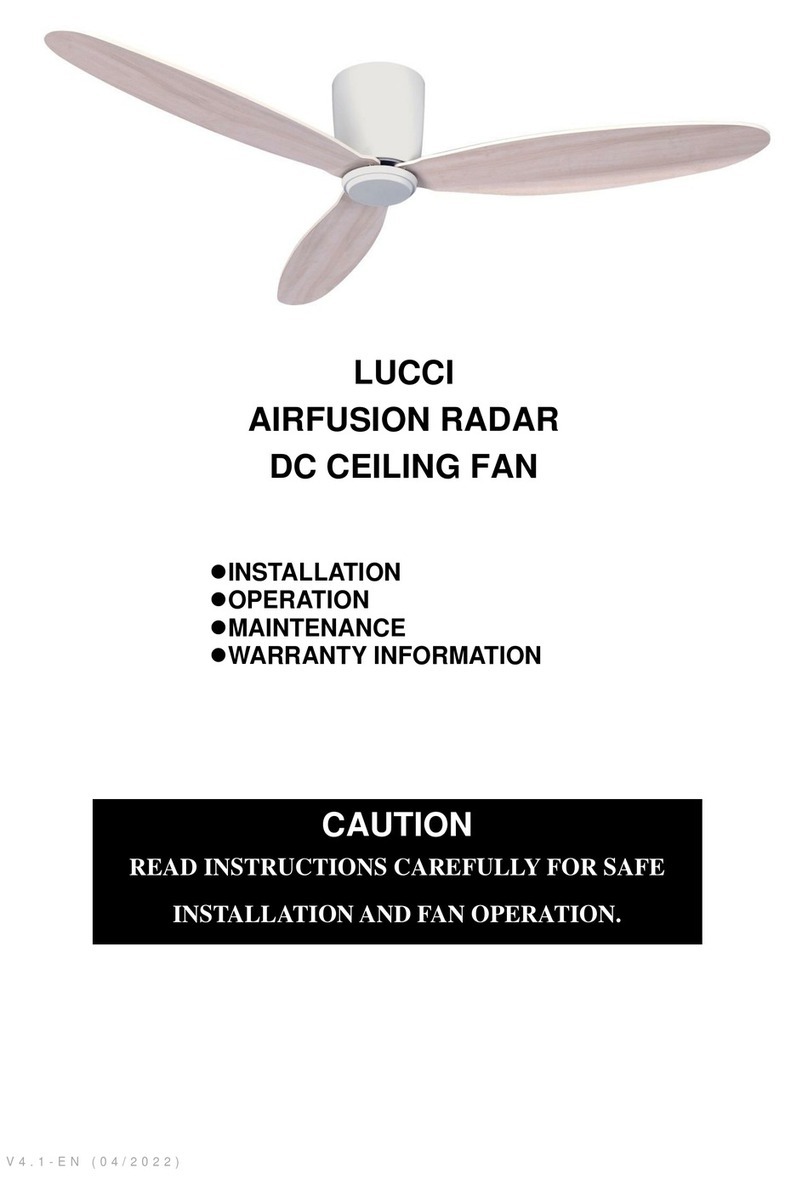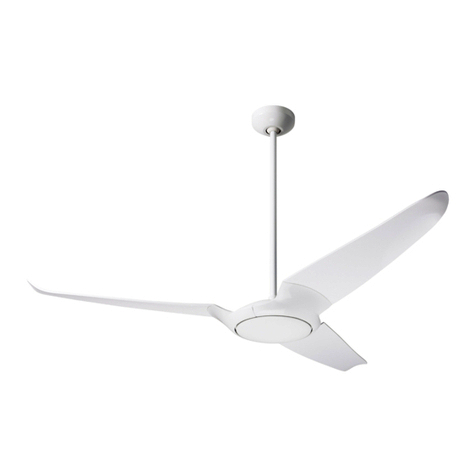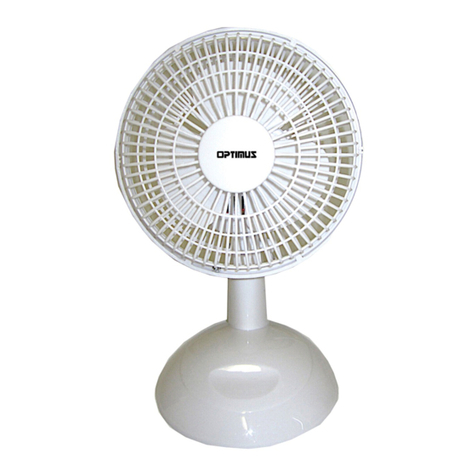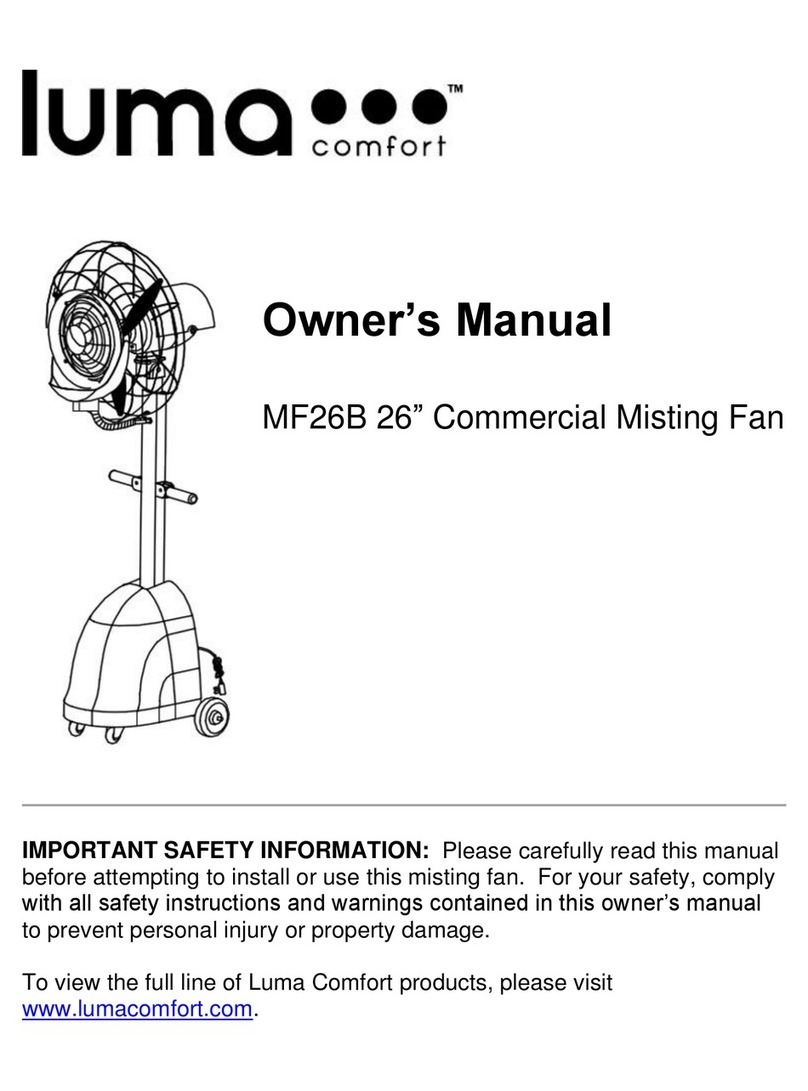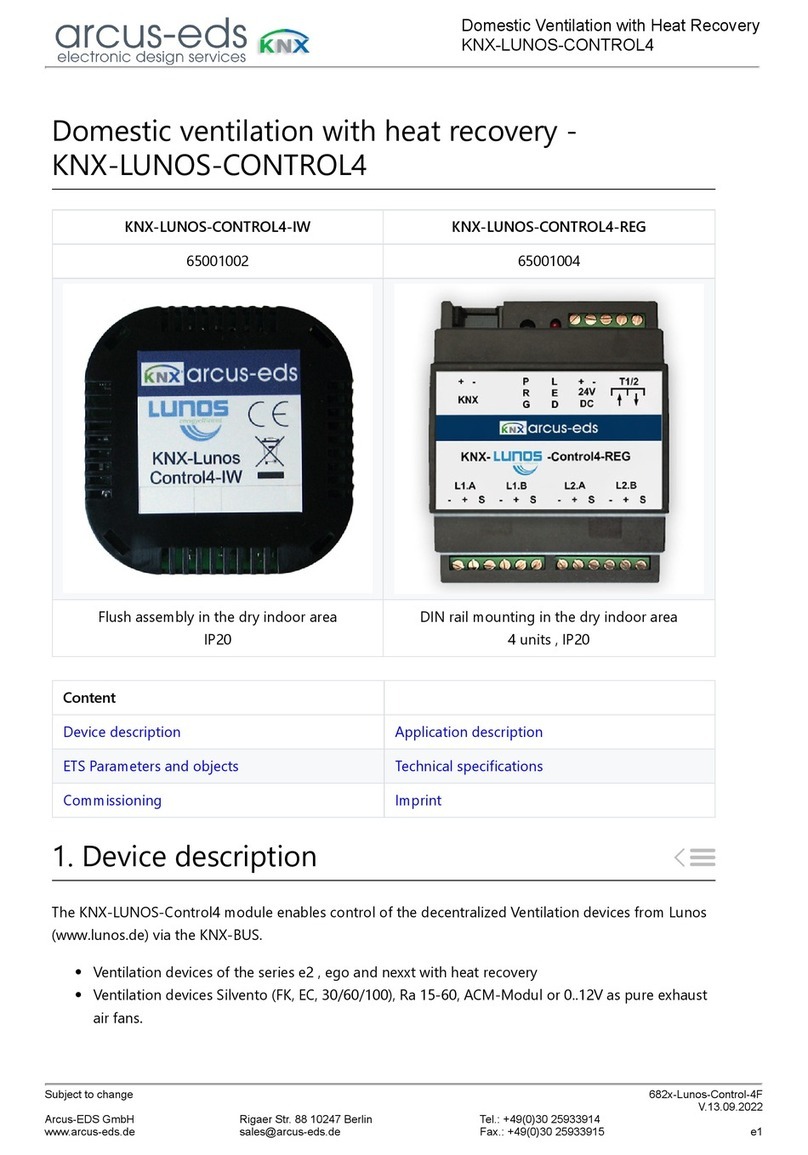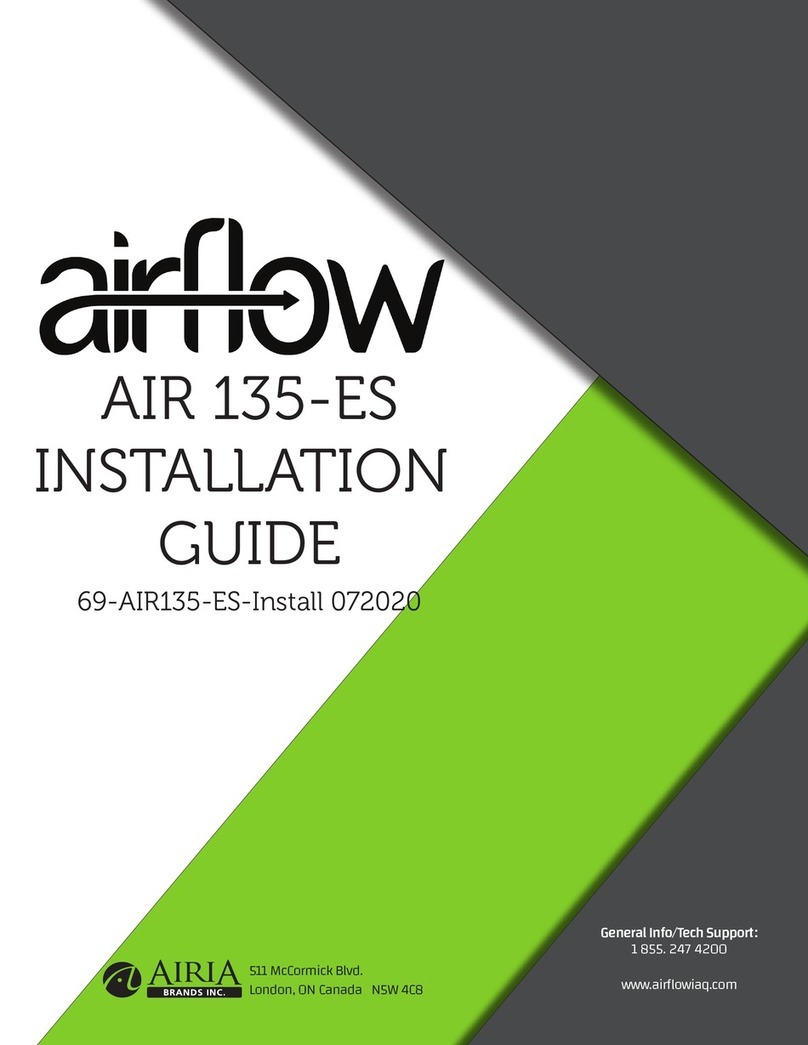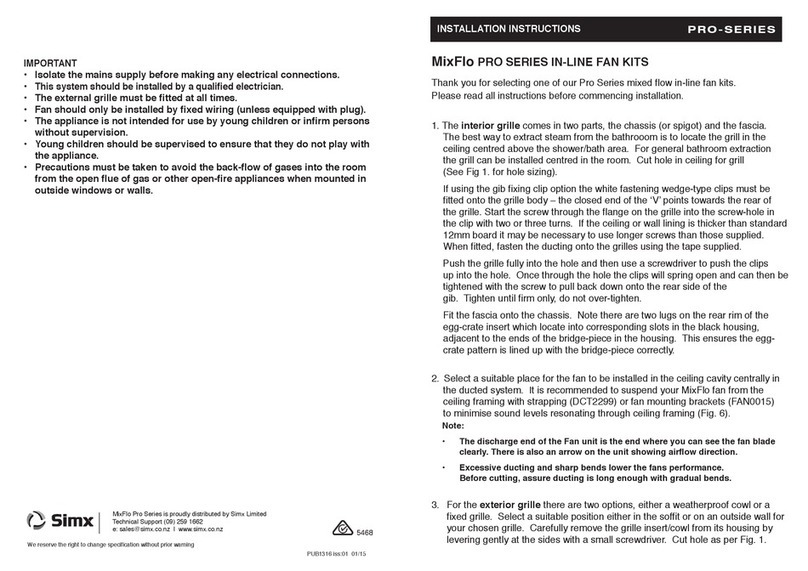NOVENCO ACP Series Instruction Manual

ACP-ACG Smoke
ACP-ACG SMOKE
INSTALLATION AND
MAINTENANCE
918816-0
English

1
918816-0
GB
MU 14424 1110
Novax Axial Flow Fans, Types ACP and ACG Smoke
Installation and Maintenance
1. Applications
2. Handling
2.1 Marking
2.2 Weight
2.3 Transport
3. Storage
4. Installation
4.1 Mounting
4.2 Before installation
4.3 Installation
4.4 Mounts
4.5 Duct connection
4.6 Wiring
5. Start-up
5.1 Before start-up
5.2 Motors with Y/Δstart
5.3 Start-up procedure
6. Maintenance
6.1 Safeguards before inspection
and maintenance
6.2 Fan housing
6.3 Impeller
6.4 Motor
6.5 Detaching the motor
6.6 Fitting the motor
6.7 Blade pitch adjustment
6.8 Fault finding
7. Testing functionality
and operational
readiness
7.1 Periodic inspection
8. Sound
9. EU declaration of
conformity
1. Applications
Novax fume fans, types ACP and ACG
Smoke, are compact, sturdy axial flow fans
suitable for meeting both everyday
ventilation requirements under normal
conditions and for extracting smoke/heat
in case of fire in all types of commercial and
industrial buildings.
Novax fume fans, types ACP and ACG
Smoke, are tested and approved, meeting
the requirements on fans for smoke
extraction in Class F300 (300°C for 60
minutes) in accordance with EN 12101-3.
2. Handling
2.1 Marking
ACP and ACG fume fans are provided with
nameplates stating Novenco's name and
address and details of fan type/size, e.g.
ACG Smoke 1000/380, number of blades,
year of manufacture, weight, serial
number/order number. The nameplate also
states maximum temperature and
operating time. If the fan has an approval
number, the nameplate states class/
category and the applicable test standard
(EN 12101-3). Finally, the nameplate states
Fan size
Motor size
-90 -100 -112 -132 -160 -180 -200 -225 -250 -280
Hub diameter
160, 230, 280, 330 and 380
400 46 56
500 60 70 78 93
560 72 82 90 105 182
630 77 87 95 110 187 219
710 85 95 103 118 195 227
800 92 102 110 125 202 234
900 103 113 121 136 213 245
1000 112 122 130 145 222 254
Hub diameter
403
900 168 245
1000 179 256 288
1120 180 195 272 304
1250 272 242 319 351
1400 263 340 372
Hub diameter
578
900 192 269 301
1000 224 301 333 421
1120 226 241 318 350 438 523
1250 272 287 364 396 484 569 654
1400 388 420 508 593 678 828
1600 547 632 717 867
Fig. 2. Total weight of ACG Smoke fans incl. motor [kg]
Fan size
Motor size
-90 -100 -112 -132 -160 -180 -200 -225 -250 -280
Hub diameter
160, 230, 280, 330 and 380
400 38 48
500 48 58 66 81
560 58 68 76 91 168
630 62 72 80 95 172 204
710 68 78 86 101 178 210
800 73 83 91 106 183 215
900 81 91 99 114 191 223
1000 88 98 106 121 198 230
Hub diameter
403
900 138 215 162
1000 146 223 255
1120 143 158 235 267
1250 185 200 277 309
1400 217 294 326
Hub diameter
578
900 163 240 272
1000 185 262 294 382
1120 187 202 279 311 399 484
1250 226 241 318 350 438 523 608
1400 337 369 457 542 627 777
1600 488 573 658 808
Fig. 1. Total weight of ACP Smoke fans incl. motor [kg]
Fig. 3. Weight of motors for ACP and ACG Smoke [kg]
Motor size -90 -100 -112 -132 -160 -180 -200 -225 -250 -280
Weight 20 30 38 53 130 162 250 335 420 570

2
fan capacity with respect to pressure, air
quantity, output and maximum speed
(rpm).
A motor nameplate with relevant motor
data, including enclosure class, is also
provided.
2.2 Weight
The total weights shown in figs 1 and 2
apply to axial flow fans, types ACP and
ACG Smoke.
The total weight is determined by the type/
size of fan and the maximum size of the
motor used, and is given in kg.
Fig. 3 shows the weights of the various
motors. The motors are LOHER fire gas
motors and the data shown, which are
applicable for both ACP and ACG Smoke,
are the maximum weights for four-pole
motors.
2.3 Transport
During transport, care must be taken to
prevent water, e.g. rainwater, from entering
the motor or other sensitive components.
Novax fume fans, types ACP and ACG
Smoke, are supplied on pallets or skids
which allow fork-lift transport. The forks
must be positioned beneath the base. The
unit must be set down as slowly as possible
on a soft surface. Impacts, vibrations and
falls may lead to imbalance and
deformation or other damage to motor
bearings.
3. Storage
Novax fume fans can withstand outdoor
storage for up to one month providing the
packaging is intact. After removing the
packaging, fans must be stored in a
rainproof shelter.
If stored indoors, fans must be kept under
well-ventilated conditions with no risk of
condensation. Under such conditions,
storage duration may be extended to six
months.
The storage place must not be exposed to
vibrations, which may damage the motor
bearings. If stored for longer than three
months, the impeller should be turned
regularly by hand.
4. Installation
4.1 Mounting
Novax axial flow fans, types ACP and ACG
Smoke, are designed to operate in either
horizontal or vertical position (the
mounting position must be determined
before drain holes in the motor are drilled).
ACP Smoke has free inlet and non-ducted
outlet.
ACG Smoke has free inlet and ducted outlet
(outlet guide vane assembly).
4.2 Before installation
Before installation, ensure that the impeller
rotates freely in the fan housing, as far as
possible with equal distance between blade
tip and fan housing around the entire
circumference.
4.3 Installation
Fans must always be installed in such a way
as to prevent contact with rotating parts.
Free inlets and outlets must be guarded by
protective grilles. If ducts are connected,
these must be provided with protective
grilles on the side of the building.
The fan is provided with an arrow plate
denoting the direction of air flow through
the fan housing. During installation, ensure
that the fan is oriented so as to provide the
desired direction of air flow in the system.
The fan is best installed using special
mounts (available as optional extras, fig. 4),
but it may also be suspended by the
housing flanges or in special hangers.
Hangers must not impede the free intake
and discharge of air.
After securing the fan in position, check
that the impeller rotates freely in the
housing.
4.4 Mounts
Mounts for types ACP and ACG Smoke
consist of two mounting plates (fig. 4 pos.
01 and 02). Beneath these, two C-profiles
(pos. 03) must be fitted using bolts (pos. 05)
and nuts (pos. 04).
The distance between the ends of the C-
profiles and the mounting plates is
determined by the fan type/size and motor
size.
.
Mount the fan housing in the two flange
holes in the mounting plates and fit the
distance bush (fig. 5, pos. 07) by means of
joining elements (pos. 08 and 09) between
inlet cone and mounting plate (pos. 06).
ACP and ACG Smoke sizes 1250-1600 have
circular fan housing. The housing is
therefore installed using mount fittings (fig.
6 pos. 07A) and joining elements (fig. 6 pos.
08A and 09A).
The fittings must be attached to the back of
the mount and fan housing as shown in fig.
6.
To prevent vibrations spreading from the
fan to the surroundings, vibration dampers
may be fitted between fan and underlying
surface and flexible connectors may be
fitted to the ducts behind the fan (available
as optional extra).
Vibration dampers (fig. 5 pos. 10) should be
fitted on the C-profile ends using bolts (pos.
11).
Base plates (pos. 12) for attachment to the
foundation/floor should be fitted beneath
the rubber dampers.
The vibration frequency of the underlying
surface must differ at least 20% from the fan
speed.
If the motor is provided with condensation
drain holes, the fan must be oriented so that
the holes face downwards (are lowest).
It is of the utmost importance for the
Fig. 4. Mount for type ACP Smoke
Fig. 5. Mount for types ACP and ACG
Smoke 400-1120
Fig. 6. Mounts for types ACP and ACG
Smoke 1250-1600

3
performance and sound level of the axial
flow fan that the air flow is unimpeded and
free of eddies.
4.5 Duct connection
Novax ACG Smoke axial flow fans are
equipped with an outlet guide vane
assembly with core. This improves fan
efficiency and allows duct connection.
The duct on the outlet side of the fan must
be designed to ensure a smooth flow of air
without turbulence. Avoid, for instance,
sharp bends or flexible connectors in the
ducting immediately behind the fan.
ACP and ACG Smoke fans are prepared for
circular duct connections on the outlet side.
Flanges supplied as standard comply with
EUROVENT 1/2.
Systems with higher vibration levels or
more exacting performance requirements
must be provided with expansion joints
between the fan and duct, and the duct
must not be supported by the fan.
It is important to provide sufficient free
space for assembling and dismantling the
system and to facilitate cleaning and
maintenance.
4.6 Wiring
Important: Do not mount a frequency
converter on a fan intended
for smoke exhaust. The
electric installation must be
designed to bypass the
frequency converter and run
the fan at nominal speed in
the event of fire.
Electrical connections must be made by an
authorised electrician in accordance with
current legislation. Power is connected via
the motor terminal box as shown in the
wiring diagrams in the terminal box cover.
Three-phase motors are connected as
shown in the wiring diagrams in the
terminal box cover.
For the connection of single-phase motors,
see wiring diagrams for single-phase
variable motors.
Having wired the motor terminal box,
check that the direction of rotation of the
impeller complies with the arrow plate
fitted on the outside of the fan.
For reversible fans (alternating direction of
rotation) a time delay must be provided to
ensure that the impeller is stationary before
restarting.
5. Start-up
5.1 Before start-up
Before start-up, check that the fan and duct
connections are clean and free of tools and
other foreign matter.
Also ensure that the electrical connections
fulfil applicable requirements, that any
protective grilles on the fan inlet or outlet
sides are correctly fitted, and that the
direction of rotation of the impeller
complies with the arrow plate (check by
briefly starting the fan).
See fig. 7 pos. 01 and 02.
5.2 Motors with Y/Δstart
The relay must be set to the calculated time.
5.3 Start-up procedure
• Start the fan.
• Check that no abnormal sound occurs.
• Check that the vibration level is
normal. At operating speed, fan
vibration must not exceed 7 mm/s
rms* measured radially at two points
with 90° offset and at the free shaft end
of the motor. Otherwise, the fan must
be rebalanced.
When fixed in position, the fan must not be
operated if vibration levels exceed 11 mm/
s rms*.
When freely suspended or mounted on
vibration dampers, the fan must not be
operated if vibration levels exceed 18 mm/
s rms*.
* ISO 2954: Mechanical vibration of rotating
and reciprocating machinery –
Requirements for instruments for
measuring vibration severity.
After thirty minutes of operation, check
that the fan operates normally.
Important: The fan is designed for
continuous operation. The
following kinds of operation
may cause fatigue break in
the impeller and endanger
people.
- Operation with pulsating
counter pressure - called
pump mode
- Operation with repeated
starting and stopping
If in doubt Novenco should
be contacted to assess the
suitability of the fan.
6. Maintenance
6.1 Safeguards prior to
inspection and maintenance
Before inspecting or servicing the fan, it
must be switched off and disconnected
from the electrical system. Also ensure that
the fan cannot be restarted unintentionally.
6.2 Fan housing
As standard, the fan housing requires no
maintenance other than cleaning.
If the housing is painted, the surface should
be checked regularly and repaired where
necessary.
6.3 Impeller
The impeller (rotor unit) is supplied with
the blades factory adjusted to the pitch
corresponding to the desired operating
point (pressure and air flow) at the fan
speed in question. To ensure vibration-free
operation the impeller has been carefully
balanced in this position.
Vibration occurring during operation is
usually the result of dust or dirt
accumulating on the hub and blades, and
Fig. 7. Novax ACG Smoke
Fig. 8. Dismantling/assembling types ACG and ACP Smoke
1. Motor
2. Motor flange
3. Wire guard
4. Motor shell
5. S-washer
6. Set screw
7. Impeller
8. Centre disc
9. Centre screw
10. Set screw
11. Washer
12. Hub
13. Outlet guide vanes
14. Nut

4
Novenco A/S
Industrivej 22 Tel. 70 12 42 22
DK-4700 Naestved Fax 55 75 65 50
www.novencogroup.com [email protected]
will disappear after cleaning. Should this
not be the case, technical assistance should
be called in immediately as continued
vibration will shorten the service life of the
blades and motor bearings.
6.4 Motor
Normally, only the motor bearings require
maintenance. This should be performed as
described in the maintenance instructions
for electric motors.
6.5 Detaching the motor
Before detaching the motor, disconnect the
power supply and motor cable. Next,
detach any ducts and outlet guide vane (fig.
8 pos. 13, 10, 11, and 14) on the fan outlet
side.
Remove the impeller centre screw (pos. 09)
and centre disc (pos. 08).
Detach the impeller using a puller secured
in the two threaded puller holes in the hub
boss (pos. 12).
Loosen the screws in the motor shell (pos.
05 and 06). The motor (pos. 01) and motor
flange (pos. 02) can then be detached.
When dismantling the fan, be careful not to
expose individual parts to impacts or other
forces that might damage the motor
bearings or fan parts.
6.6 Fitting the motor
After servicing is complete the motor must
be refitted. Check that the motor flange (fig.
8 pos. 02) is correctly positioned and that
the motor shaft is concentrically positioned
in the fan housing before tightening the
bolts (pos. 06).
Refit the impeller (pos. 07) on the motor
shaft by means of a puller secured in the
threaded hole on the motor shaft. Tighten
the impeller hub against the motor shaft
collar. Check that blade clearance is equal
around the entire circumference of the
housing. If this is not the case, adjust the
motor position in the suspension system.
Now fit the centre screw (pos. 09) and centre
disc (pos. 08). It is recommended that lock
washers and lock nuts be replaced when
reassembling the fan. Finally, connect the
motor cable in the terminal box (pos. 01)
and any ducts and outlet guide vane (pos.
13).
To restart the fan, follow the procedure
described in section 5: Start-up.
6.7 Blade pitch adjustment
The blade pitch is factory adjusted using a
special tool (fixture) to provide the output
required by the customer/order on
delivery.
If a different output is required, it is possible
to alter blade pitch. This requires
knowledge of the motor load and the max.
permissible blade pitch in relation to the
motor rating (in case of blade pitch
increase).
Please contact Novenco before any such
adjustment of blade pitch. Special tools for
blade pitch adjustment and instructions for
impeller balancing are available from
Novenco.
A brochure describing the blade pitch tool
and its use is available on request.
6.8 Fault finding
Possible operating faults are described in
the following.
Insufficient output:
Blocked air supply on the inlet side:
• Damper closed
•Ductblocked
• Supply fan, if any, stopped
•Motordefective
• Motor cut out
• Incorrect direction of impeller rotation
Noise/vibration:
• Bearings in electric motor defective
• Impeller out of balance
• Impeller worn/damaged
• Bolts/components loose
• Impeller blades have different pitch
• Fan operating in "stall" mode – this
may damage the system and should be
remedied immediately, see
"Insufficient output".
7. Testing functionality
and operational
readiness
To maintain their fire approval, ACP and
ACG Smoke fans must be tested every three
months with respect to functionality and
operational readiness.
If ACP and ACG Smoke fans are also used
for ventilation purposes, such tests need
only be performed at six-month intervals
provided the fan is started at least once a
day by means of a time switch or carbon
monoxide sensor.
7.1 Periodic inspection
Novax fume fans must always be
maintained in proper operating condition.
To ensure satisfactory operation and long
service life, the fans should be inspected
every six months.
Such inspection should include the
following:
• Measurement of power consumption
• Measurement of fan housing vibration
• Control of fixation bolt torque and, if
necessary, readjustment
• Visual inspection of impeller, housing
and wiring
•Cleaning:
– Use compressed air to clean the
inside
– Use water to clean the outside
It is recommended that a log be kept of all
values and observations.
8. Sound
The sound generated by the fans depends
on installation and operating conditions,
and general data on sound generation is
therefore unavailable.
For further details, please refer to our
catalogue material or computer programs
designed to calculate specific sound
emissions.
9. EU declaration of
conformity
Novenco A/S
Industrivej 22
DK-4700 Naestved
hereby declares that ACP Smoke 400-1600
and ACG Smoke 400-1600 axial flow fans
have been manufactured in conformity
with Council Directive 2006/42/EC on the
approximation of the laws of the member
states relatingto machinery (the Machinery
Directive).
Directives
– EC Machinery Directive 2006/42/EC
– EMC Directive 2004/108/EC)
– Low Voltage Directive 2006/95/EC
Applied standards
EN ISO 12100-1: Safety of machinery -
Part 1
EN 12100-2: Safety of machinery -
Part 2
EN 13857: Safety of machinery -
Safety distances
EN 12101-3: Smoke and heat control
systems - Part 3, class 1
EN 60204-1: Safety of machinery -
Electrical equipment of
machines - Part 1:
General Requirements
It is a condition that Novenco installation
instructions have been followed.
Naestved, 1.11.2010
Steen Hansen
R&D manager
Novenco A/S

WWW.NOVENCO-BUILDING.COM
ACP-ACG Smoke
This manual suits for next models
1
Table of contents
Other NOVENCO Fan manuals

NOVENCO
NOVENCO NOVAX ACN-ACW-ARN Instruction Manual
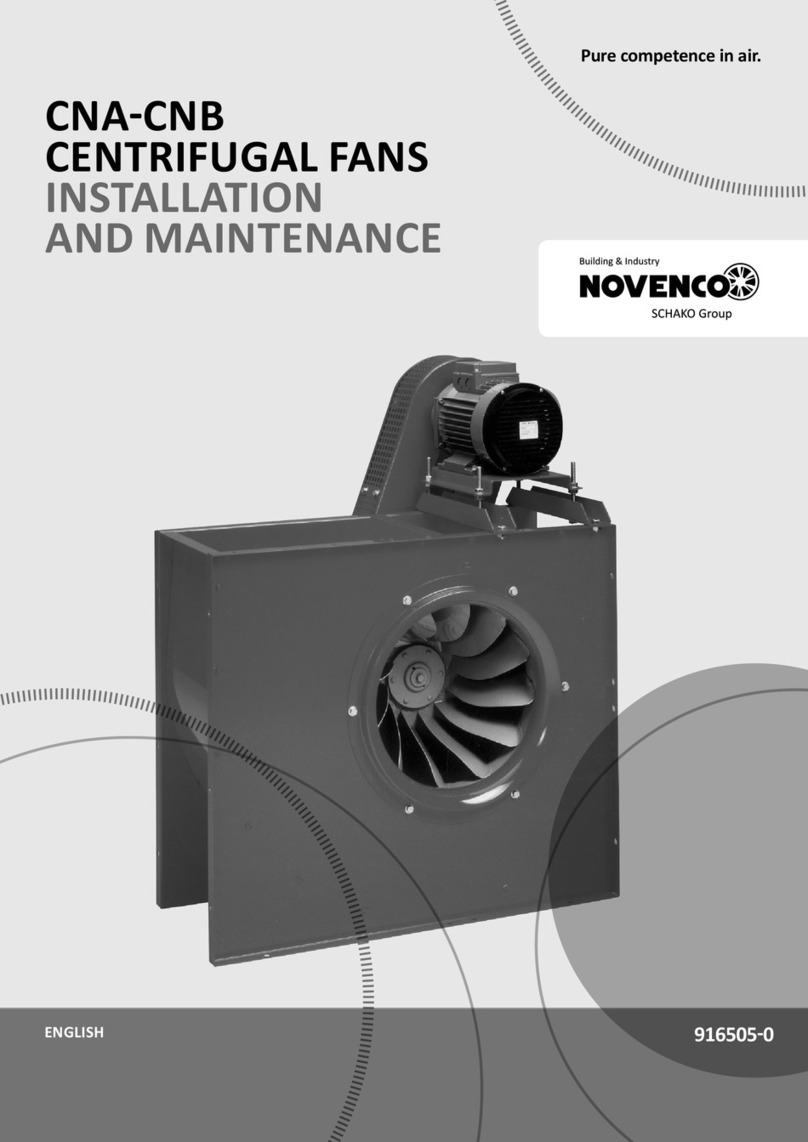
NOVENCO
NOVENCO CNA Series Instruction Manual
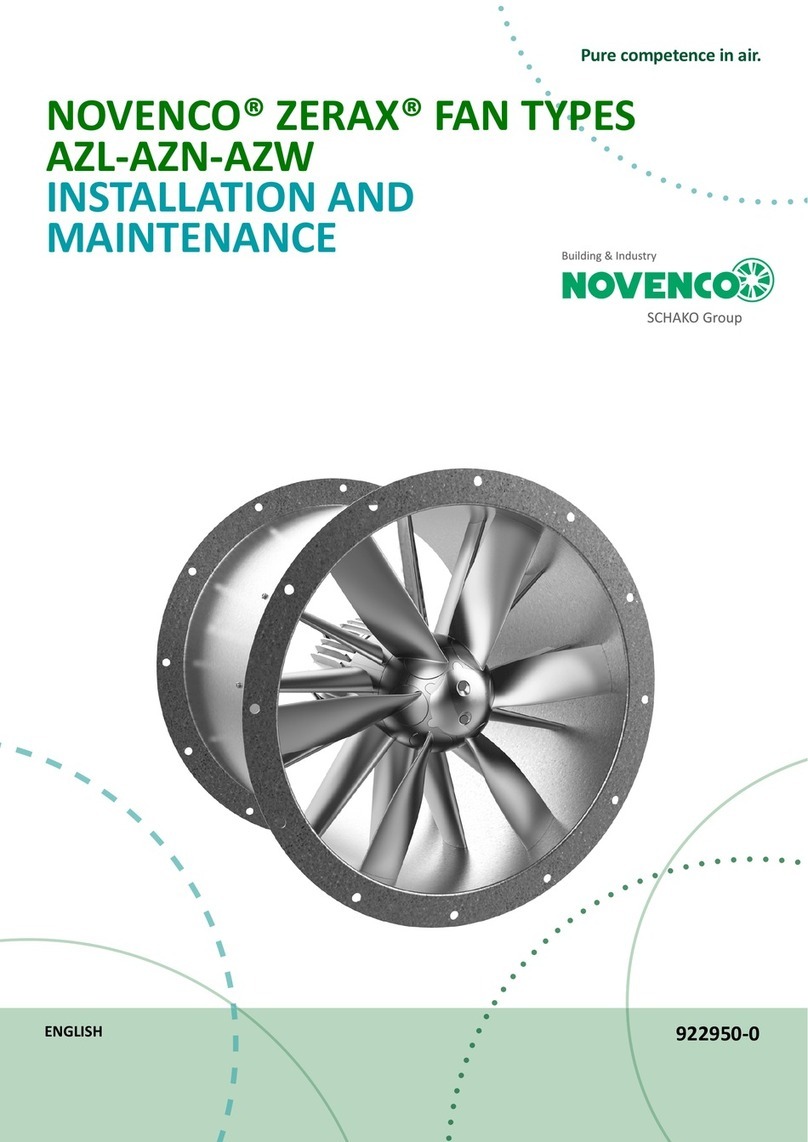
NOVENCO
NOVENCO ZERAX AZL-AZN-AZW Instruction Manual

NOVENCO
NOVENCO AUO 290 Instruction Manual

NOVENCO
NOVENCO Novax Instruction Manual

NOVENCO
NOVENCO FALKINN ACN Instruction Manual
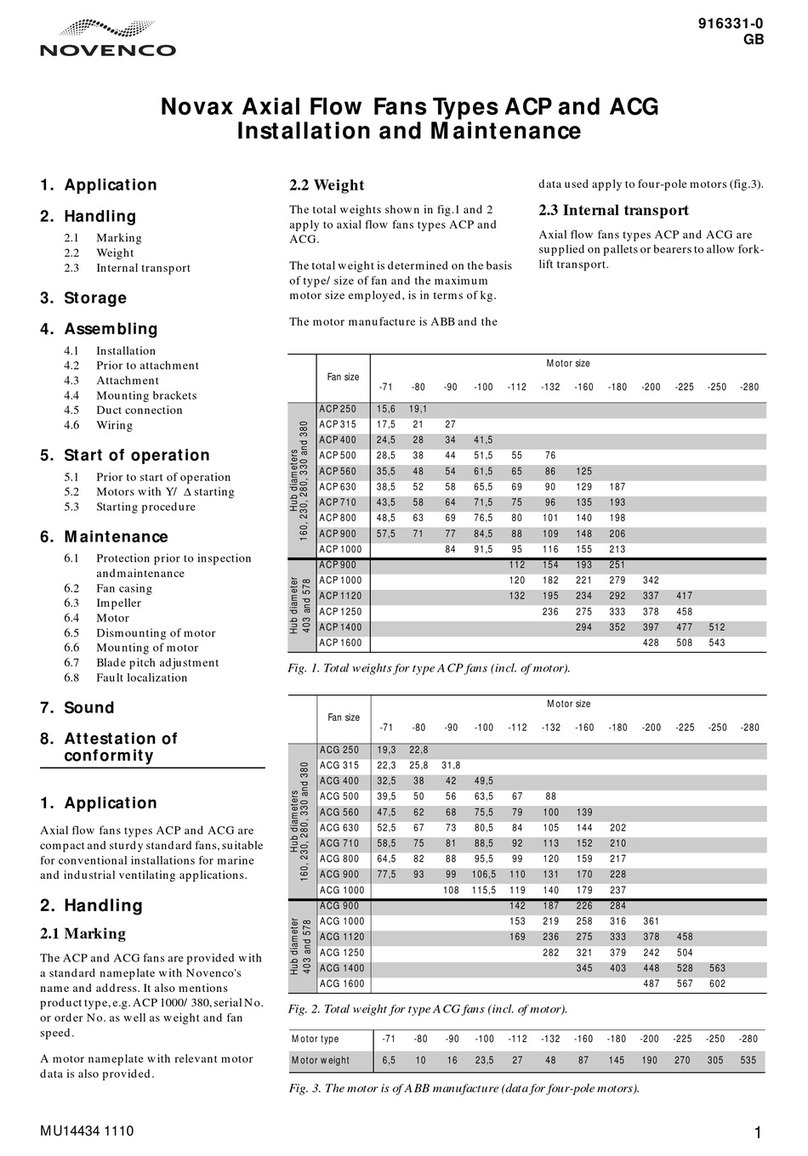
NOVENCO
NOVENCO Novax ACP Series Instruction Manual
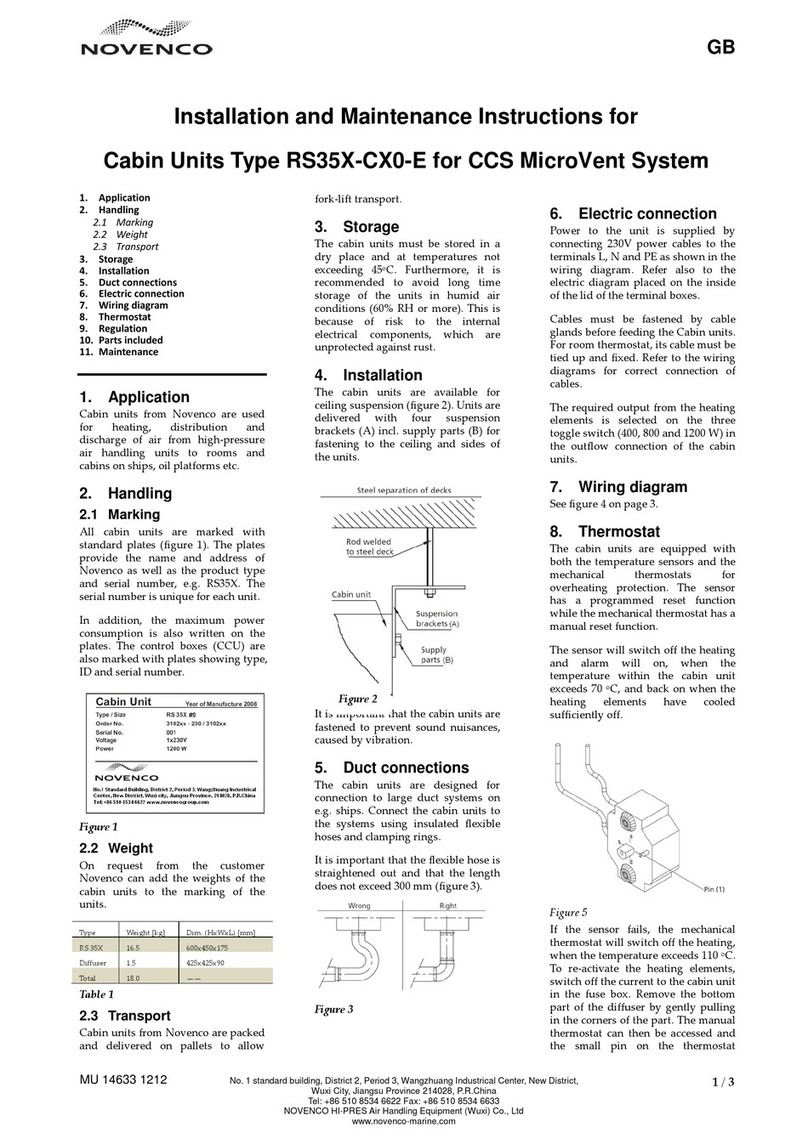
NOVENCO
NOVENCO RS35x-CX0-E series User manual
Popular Fan manuals by other brands
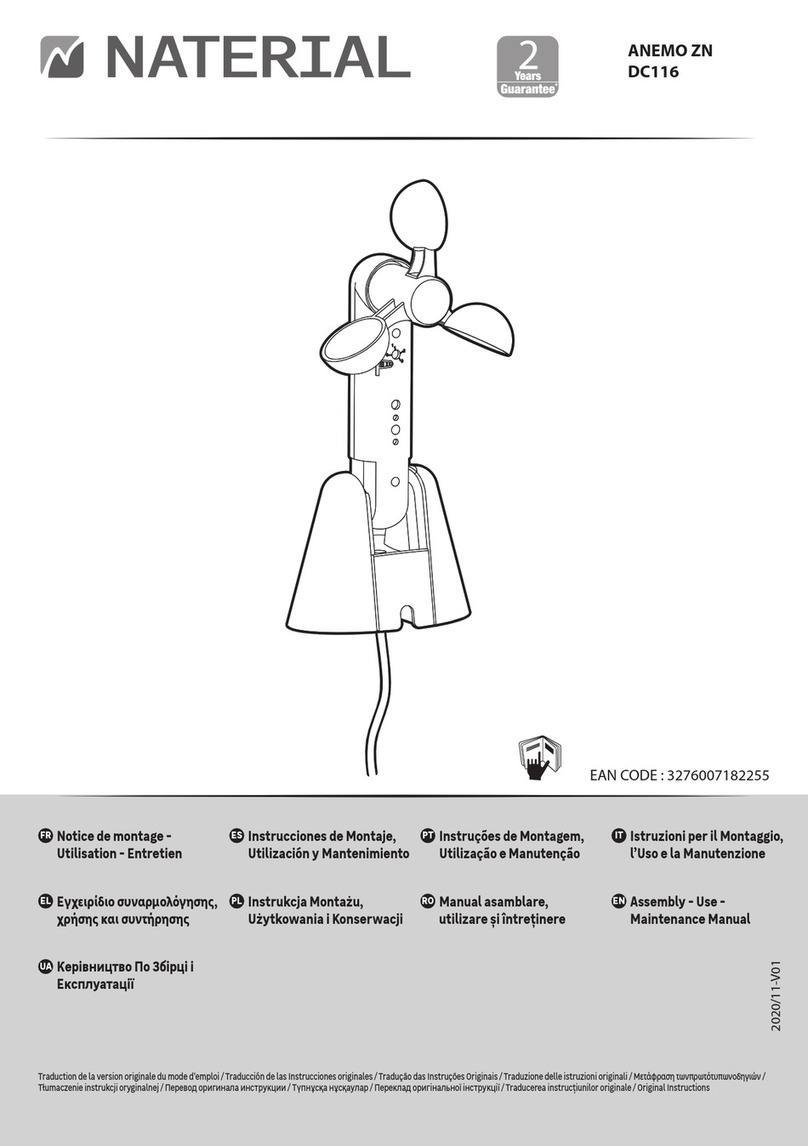
Naterial
Naterial ANEMO ZN DC116 Assembly, Use, Maintenance Manual
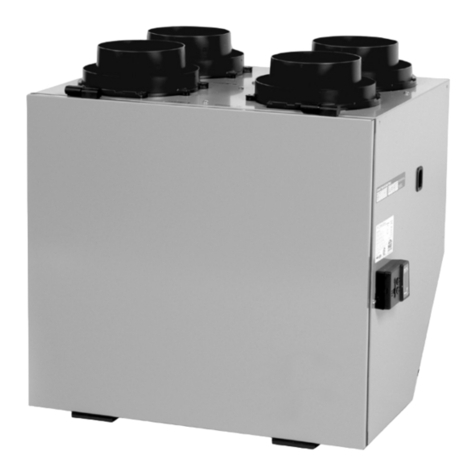
S&P
S&P HR100V Homeowner's guide
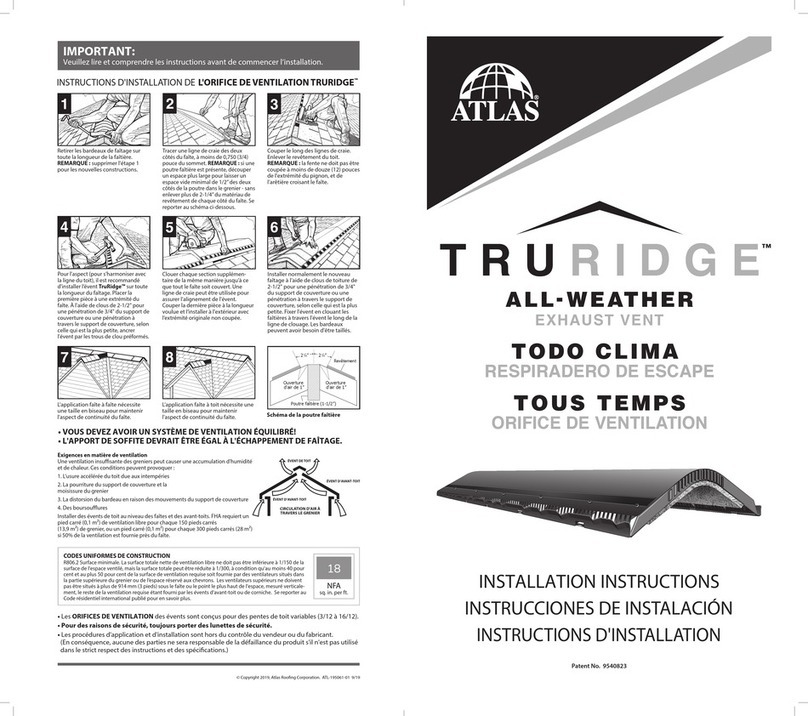
Atlas
Atlas Trueridge ALL- WEATHER installation instructions
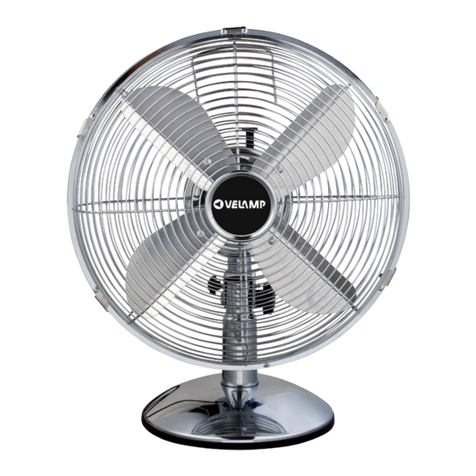
Vetech
Vetech VENT-M30T3 instruction manual

Unold
Unold BREEZY SWING Instructions for use
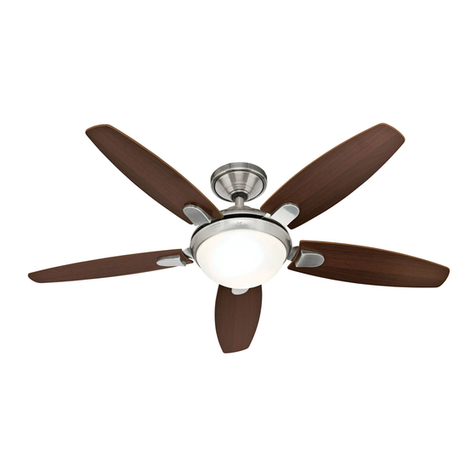
Hunter
Hunter Contempo 59013 Owner's guide and installation manual

